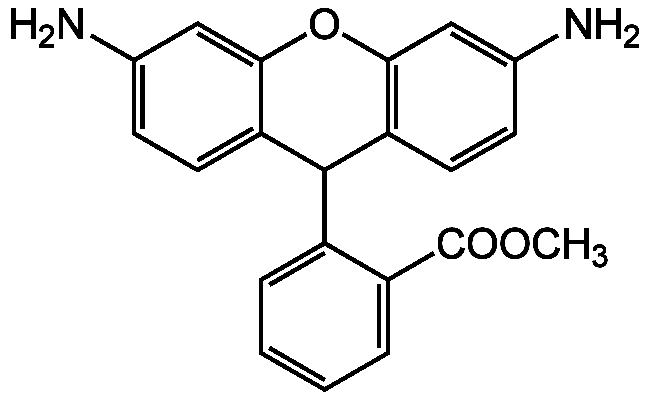Dihydrorhodamine 123
Product Code:
CDX-D0134
CDX-D0134
Regulatory Status:
RUO
RUO
Shipping:
Ambient
Ambient
Storage:
-20 °C
-20 °C
No additional charges, what you see is what you pay! *
| Code | Size | Price |
|---|
| CDX-D0134-M002 | 2 mg | £86.00 |
Quantity:
| CDX-D0134-M010 | 10 mg | £195.00 |
Quantity:
| CDX-D0134-M125 | 125 mg | £1,749.00 |
Quantity:
Prices exclude any Taxes / VAT
Stay in control of your spending. These prices have no additional charges, not even shipping!
* Rare exceptions are clearly labelled (only 0.14% of items!).
* Rare exceptions are clearly labelled (only 0.14% of items!).
Multibuy discounts available! Contact us to find what you can save.
This product comes from: Switzerland.
Typical lead time: 7-10 working days.
Contact us for more accurate information.
Typical lead time: 7-10 working days.
Contact us for more accurate information.
- Further Information
- Documents
- References
- Related Products
- Show All
Further Information
Alternate Names/Synonyms:
DHR
Appearance:
Pink solid.
CAS:
109244-58-8
EClass:
32160000
Form (Short):
liquid
Handling Advice:
Protect from light and moisture.
InChi:
InChI=1S/C21H18N2O3/c1-25-21(24)15-5-3-2-4-14(15)20-16-8-6-12(22)10-18(16)26-19-11-13(23)7-9-17(19)20/h2-11,20H,22-23H2,1H3
InChiKey:
FNEZBBILNYNQGC-UHFFFAOYSA-N
Long Description:
Chemical. CAS: 109244-58-8. Formula: C21H18N2O3. MW: 346.38. Synthetic. Cell-permeable non-fluorescent reactive oxygen species (ROS) indicator. Passively diffuses across membranes where it is oxidized by peroxynitrite to rhodamine 123 which localizes in the mitochondria and exhibits green fluorescence (Ex/Em wavelengths of 500 and 536 nm). Used to investigate reactive oxygen intermediates produced by human and murine phagocytes, activated rat mast cells and cultured endothelial cells. In addition, it has been used together with Fura Red calcium indicator to simultaneously measure oxidative bursts and Ca2+ fluxes in monocytes and granulocytes. Dihydrorhodamine 123 has been shown to be a more sensitive probe than H2DCFDA for detecting granulocyte respiratory bursts.
MDL:
MFCD04221428
Molecular Formula:
C21H18N2O3
Molecular Weight:
346.38
Package Type:
Vial
Product Description:
Cell-permeable non-fluorescent reactive oxygen species (ROS) indicator. Passively diffuses across membranes where it is oxidized by peroxynitrite to rhodamine 123 which localizes in the mitochondria and exhibits green fluorescence (Ex/Em wavelengths of 500 and 536 nm). Used to investigate reactive oxygen intermediates produced by human and murine phagocytes, activated rat mast cells and cultured endothelial cells. In addition, it has been used together with Fura Red calcium indicator to simultaneously measure oxidative bursts and Ca2+ fluxes in monocytes and granulocytes. Dihydrorhodamine 123 has been shown to be a more sensitive probe than H2DCFDA for detecting granulocyte respiratory bursts.
Purity:
>95% (NMR)
SMILES:
COC(=O)C1=CC=CC=C1C1C2=CC=C(N)C=C2OC2=C1C=CC(N)=C2
Solubility Chemicals:
Soluble in DMSO, DMF or ethanol.
Source / Host:
Synthetic.
Transportation:
Non-hazardous
UNSPSC Category:
Fluorescent Reagents
UNSPSC Number:
41105331
Use & Stability:
Stable for at least 2 years after receipt when stored at -20°C.
Documents
References
(1) K. Hensley et al.; Meth. Biol. Oxidative Stress 169 (2003) | (2) H. Ischiropoulos et al.; Meth. Enzymology 301, 367 (1999) | (3) L.M. Henderson et al.; Europ. J. Biochem. FEBS 217(3), 973 (1993) An unappreciated role for neutrophil-DC hybrids in immunity to invasive fungal infections: J.S. Fites, et al.; PLoS Pathog. 14, e1007073 (2018) | The Salmonella type-3 secretion system-1 and flagellar motility influence the neutrophil respiratory burst: T.L. Westerman, et al.; PLoS One 13, e0203698 (2018)
Related Products
| Product Name | Product Code | Supplier | Rhodamine 110 chloride | CDX-R0016 | Chemodex | Summary Details | |||||||||||||||||||||||||||||||||||||||||||||||||||||||||||||||||||||||||||||||||||||||||||||
|---|---|---|---|---|---|---|---|---|---|---|---|---|---|---|---|---|---|---|---|---|---|---|---|---|---|---|---|---|---|---|---|---|---|---|---|---|---|---|---|---|---|---|---|---|---|---|---|---|---|---|---|---|---|---|---|---|---|---|---|---|---|---|---|---|---|---|---|---|---|---|---|---|---|---|---|---|---|---|---|---|---|---|---|---|---|---|---|---|---|---|---|---|---|---|---|---|---|---|---|
| Sulforhodamine 101 | CDX-S0025 | Chemodex | Summary Details | ||||||||||||||||||||||||||||||||||||||||||||||||||||||||||||||||||||||||||||||||||||||||||||||||



